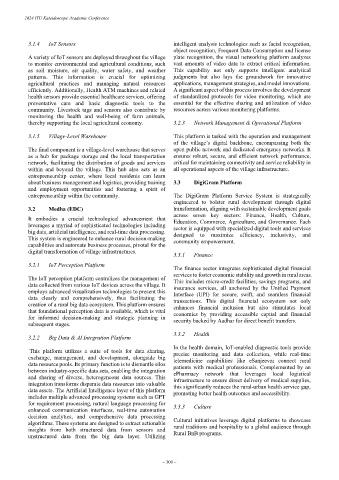Page 344 - Kaleidoscope Academic Conference Proceedings 2024
P. 344
2024 ITU Kaleidoscope Academic Conference
3.1.4 IoT Sensors intelligent analysis technologies such as facial recognition,
object recognition, Frequent Data Consumption and license
A variety of IoT sensors are deployed throughout the village plate recognition, the visual networking platform analyzes
to monitor environmental and agricultural conditions, such vast amounts of video data to extract critical information.
as soil moisture, air quality, water safety, and weather This capability not only supports intelligent analytical
patterns. This information is crucial for optimizing judgments but also lays the groundwork for innovative
agricultural practices and managing natural resources applications, management strategies, and model innovations.
efficiently. Additionally, Health ATM machines and related A significant aspect of this process involves the development
health sensors provide essential healthcare services, offering of standardized protocols for video monitoring, which are
preventative care and basic diagnostic tools to the essential for the effective sharing and utilization of video
community. Livestock tags and sensors also contribute by resources across various monitoring platforms.
monitoring the health and well-being of farm animals,
thereby supporting the local agricultural economy. 3.2.3 Network Management & Operational Platform
3.1.5 Village-Level Warehouse This platform is tasked with the operation and management
of the village’s digital backbone, encompassing both the
The final component is a village-level warehouse that serves open public network and dedicated emergency networks. It
as a hub for package storage and the local transportation ensures robust, secure, and efficient network performance,
network, facilitating the distribution of goods and services critical for maintaining connectivity and service reliability in
within and beyond the village. This hub also acts as an all operational aspects of the village infrastructure.
entrepreneurship center, where local residents can learn
about business management and logistics, providing training 3.3 DigiGram Platform
and employment opportunities and fostering a spirit of
entrepreneurship within the community. The DigiGram Platform Service System is strategically
engineered to bolster rural development through digital
3.2 Medha (EDC) transformation, aligning with sustainable development goals
across seven key sectors: Finance, Health, Culture,
It embodies a crucial technological advancement that Education, Commerce, Agriculture, and Governance. Each
leverages a myriad of sophisticated technologies including sector is equipped with specialized digital tools and services
big data, artificial intelligence, and real-time data processing. designed to maximize efficiency, inclusivity, and
This system is engineered to enhance rural decision-making community empowerment.
capabilities and automate business processes, pivotal for the
digital transformation of village infrastructures.
3.3.1 Finance
3.2.1 IoT Perception Platform
The finance sector integrates sophisticated digital financial
services to foster economic stability and growth in rural areas.
The IoT perception platform centralizes the management of This includes micro-credit facilities, savings programs, and
data collected from various IoT devices across the village. It insurance services, all anchored by the Unified Payment
employs advanced visualization technologies to present this Interface (UPI) for secure, swift, and seamless financial
data clearly and comprehensively, thus facilitating the transactions. This digital financial ecosystem not only
creation of a rural big data ecosystem. This platform ensures enhances financial inclusion but also stimulates local
that foundational perception data is available, which is vital economies by providing accessible capital and financial
for informed decision-making and strategic planning in security backed by Aadhar for direct benefit transfers.
subsequent stages.
3.3.2 Health
3.2.2 Big Data & AI Integration Platform
In the health domain, IoT-enabled diagnostic tools provide
This platform utilizes a suite of tools for data sharing, precise monitoring and data collection, while real-time
exchange, management, and development, alongside big telemedicine capabilities like eSanjeevni connect rural
data resource pools. Its primary function is to dismantle silos patients with medical professionals. Complemented by an
between industry-specific data sets, enabling the integration ePharmacy network that leverages local logistical
and sharing of diverse, heterogeneous data sources. This infrastructure to ensure direct delivery of medical supplies,
integration transforms disparate data resources into valuable this significantly reduces the rural-urban health service gap,
data assets. The Artificial Intelligence layer of this platform promoting better health outcomes and accessibility.
includes multiple advanced processing systems such as GPT
for requirement processing, natural language processing for
enhanced communication interfaces, real-time automation 3.3.3 Culture
decision analytics, and comprehensive data processing
algorithms. These systems are designed to extract actionable Cultural initiatives leverage digital platforms to showcase
insights from both structured data from sensors and rural traditions and hospitality to a global audience through
Rural BnB programs.
unstructured data from the big data layer. Utilizing
– 300 –

